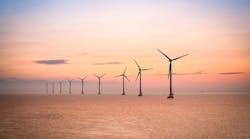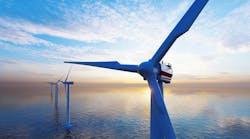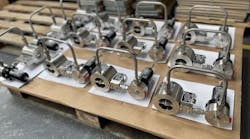Fast-track, very low cost option for other US Gulf fields
Bev Edwards
Kerr McGee Oil & Gas
- Workmen finish hooking up Kerr McGee's Ship Shoal Block 28 well #26 after workover and a new protector platform. The well is one of the earliest drilled in the Gulf of Mexico out of sight of land. [35,123 bytes]
- Well protectors are installed around producing wells on a Ship Shoal block by Kerr McGee to maintain production life that is approaching 50 years. [36,932 bytes]
The industry wanders through the technical production choices of tension leg platforms (TLP), spars, compliant towers, floating production, storage and offloading systems (FPSO) and subsea tiebacks to shallow water platforms. The capital risks are very large, with some high dollar numbers.
Somewhere in all of this frenzy, the industry tends to forget about the shallow water leases - where the US offshore industry started, some fifty years ago. The production methods seem to be simple creatures of the past. Maybe some US operators are overlooking opportunities in the shallow US Gulf.
Invisible reserves
Three dimensional seismic and enhanced logging techniques have opened a lot of windows to see reserves not visible in the past. The industry is finding new life in old fields with new geotechnology.Existing shallow water leases in the Gulf of Mexico are yielding oil and gas reserves that have been passed over. Old leases that are still on production have an infrastructure of production platforms and pipelines to market that are already in place and largely paid out a long time ago.
Sometimes, we get a wake up call when another operator wants to buy a lease that we feel is largely depleted of recoverable reserves. What do they see that we have overlooked? This starts the search that often leads to moving up an existing well casing and perforating and completing a pay zone that has been left behind the pipe.
Sidetrack wells from existing holes and new slant and horizontal wells from existing well protector platforms are becoming more common. These can be very quick and low cost additional reserves produced from existing facilities. The gas marketing folks gave this the nickname of fast gas.
Remodeling oil fields
Old production facilities often require a remodeling job in the summer before they are ready to deliver product for the winter heating season, when product prices traditionally rise. This was the case for Kerr McGee's construction department, which was engaged in building new platforms and pipelines on one of the oldest leases in the Gulf of Mexico.The shallow water Ship Shoal Block 32 field was Kerr McGee's first offshore discovery and the first commercial discovery "out of sight of land" some 50 years ago (1947). The field is off the Louisiana coast, in 22 ft water depths.
The workover of Ship Shoal 32 well #12 this past spring produced a steady flow of about 300 b/d of oil. The well protector platform was very much in need of repair, so Kerr McGee opted to build a new 4-pile platform, rather than try to repair the old one.
Likewise neighboring Ship Shoal Block 28 well #26 in 13 ft water depth and Ship Shoal 29 well #6 in 15 ft water depth showed promise of additional reserves, so they received new 4-pile well protector platforms. Economies of scale worked to Kerr McGee's advantage.
The company fabricated all three platforms at the same time, and installed them together with one mobilization of construction equipment. The three platforms were fabricated by Twin Brothers, TCB Industries and General Fabricators in their south Louisiana yards. Construction and installation cost for the three-platform package was about $1 million total.
Fabricating three platforms in parallel took about one month. All three platforms were installed by one jackup derrick barge in two weeks total. This is a relatively inexpensive road to new reserves.
Teamwork and trust in suppliers and contractors were the methods of success. Team members included design by TEC Engineers
of New Orleans, fabrication by the three companies mentioned, installation by Global Industries jackup derrick and TCB Industries hookup crews. The Kerr McGee drilling, production and construction departments worked closely together to complete the task.
Other projects
Other projects in the US Gulf for Kerr McGee included major modifications and production equipment upgrades to Ship Shoal Block 229A and Ship Shoal Block 230B 4-pile production platforms in 130 ft of water and pipelines to bring new wells on stream on older platforms.Less than three months of construction time was required to rebuild existing production facilities to API specifications. If Kerr McGee had purchased new production equipment at higher cost, it would have required about eight months time.
Rebuilding existing vessels saves perhaps 20% over the cost of new, while finishing five months early with rebuilt vessels. Both bring a significant cash flow advantage. A spirit of teamwork made these fast track projects possible.
Copyright 1997 Oil & Gas Journal. All Rights Reserved.




